Do you have a question about the Behringer EURORACK UB2222FX-PRO and is the answer not in the manual?
Explains the three primary functions of a mixing console: signal processing, level setting, and effects mixing.
Details the high-end IMP preamplifiers, their dynamic range, bandwidth, and low-noise circuitry.
Describes the built-in 24-bit multi-effects processor and the FBQ Feedback Detection System.
Guides users on understanding the manual's structure and controls for effective mixer operation.
Provides instructions for inspecting shipments, initial setup, and safe operation of the mixer.
Details microphone and line inputs, gain, low cut filter, and insert points on mono channels.
Explains the 3-band equalizer with semi-parametric mid bands for sound shaping.
Describes how to use monitor and effects busses for routing signals to external devices or monitors.
Details routing switches, mute/solo functions, clip indicators, and channel fader operation.
Explains stereo channel inputs, level selection, and gain controls for left and right channels.
Details stereo channel EQ, aux sends, balance control, and routing options.
Introduces the main section controls, including aux send masters and monitor controls.
Details the use of stereo aux return jacks for effects or additional line inputs.
Explains the separate monitor output and its controls on the UB1832FX-PRO model.
Describes how to control the level of stereo aux returns in the main mix.
Provides additional routing options for the UB1832FX-PRO's FX/AUX 2 return fader.
Covers XPQ surround, voice canceller, 2-track input/output, and level metering.
Explains the function of subgroup and main mix faders and their associated switches.
Details the graphic stereo equalizer and the FBQ Feedback Detection System for sound control.
Describes the built-in effects processor, presets, and how to use external effects.
Covers main mix outputs, insert points for dynamic processing, and control room outputs.
Explains subgroup outputs for routing mixes and direct outputs for multi-track recording.
Details voltage supply, phantom power activation, and fuse replacement guidelines.
Provides instructions for securely mounting the mixing console in a 19-inch rack.
Explains how to connect various audio cables, including TS, TRS, and XLR connectors.
Presents comprehensive technical data for microphone inputs, line inputs, aux sends, and returns.
Details noise performance, frequency responses, EQ characteristics, and impedance ratings.
Details the FCC rules and compliance for the Class B digital device, including interference guidelines.
Explains the three primary functions of a mixing console: signal processing, level setting, and effects mixing.
Details the high-end IMP preamplifiers, their dynamic range, bandwidth, and low-noise circuitry.
Describes the built-in 24-bit multi-effects processor and the FBQ Feedback Detection System.
Guides users on understanding the manual's structure and controls for effective mixer operation.
Provides instructions for inspecting shipments, initial setup, and safe operation of the mixer.
Details microphone and line inputs, gain, low cut filter, and insert points on mono channels.
Explains the 3-band equalizer with semi-parametric mid bands for sound shaping.
Describes how to use monitor and effects busses for routing signals to external devices or monitors.
Details routing switches, mute/solo functions, clip indicators, and channel fader operation.
Explains stereo channel inputs, level selection, and gain controls for left and right channels.
Details stereo channel EQ, aux sends, balance control, and routing options.
Introduces the main section controls, including aux send masters and monitor controls.
Details the use of stereo aux return jacks for effects or additional line inputs.
Explains the separate monitor output and its controls on the UB1832FX-PRO model.
Describes how to control the level of stereo aux returns in the main mix.
Provides additional routing options for the UB1832FX-PRO's FX/AUX 2 return fader.
Covers XPQ surround, voice canceller, 2-track input/output, and level metering.
Explains the function of subgroup and main mix faders and their associated switches.
Details the graphic stereo equalizer and the FBQ Feedback Detection System for sound control.
Describes the built-in effects processor, presets, and how to use external effects.
Covers main mix outputs, insert points for dynamic processing, and control room outputs.
Explains subgroup outputs for routing mixes and direct outputs for multi-track recording.
Details voltage supply, phantom power activation, and fuse replacement guidelines.
Provides instructions for securely mounting the mixing console in a 19-inch rack.
Explains how to connect various audio cables, including TS, TRS, and XLR connectors.
Presents comprehensive technical data for microphone inputs, line inputs, aux sends, and returns.
Details noise performance, frequency responses, EQ characteristics, and impedance ratings.
Details the FCC rules and compliance for the Class B digital device, including interference guidelines.
| Headphone out | Yes |
|---|---|
| Product color | Silver |
| Video capability | No |
| Equalizer bands quantity | 3 |
| Microphone input impedance | 2600 Ω |
| Channels quantity | 5 channels |
| Channel fader (1kHz) | 89 dB |
| Digital sound processing | 24 bit |
| XLR out | 2 |
| Depth | 355 mm |
|---|---|
| Width | 430 mm |
| Height | 90 mm |
| Weight | 5500 g |
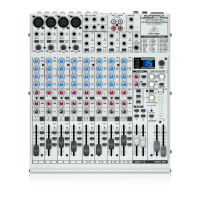
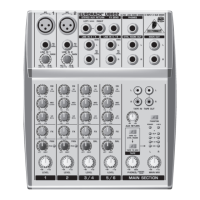
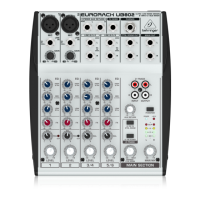

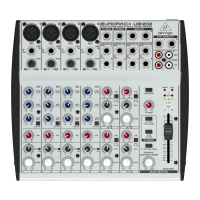
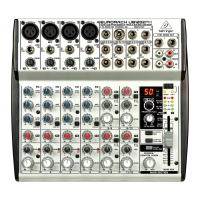
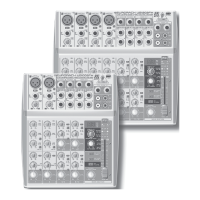

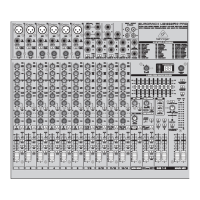
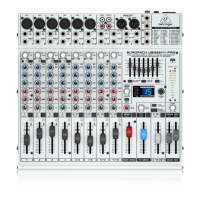

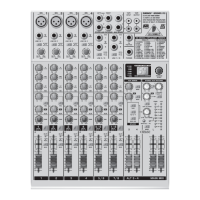
